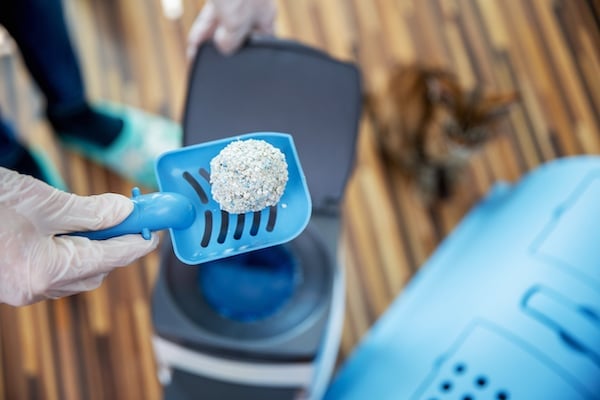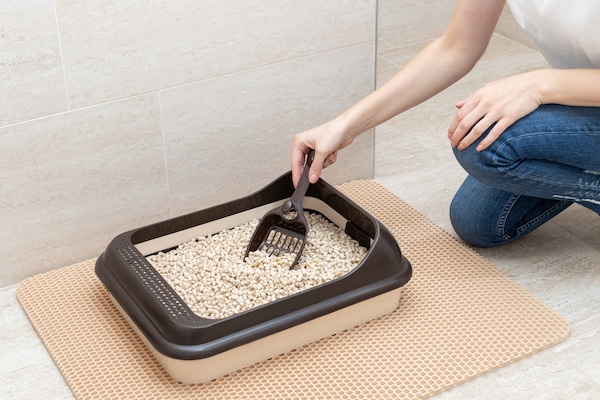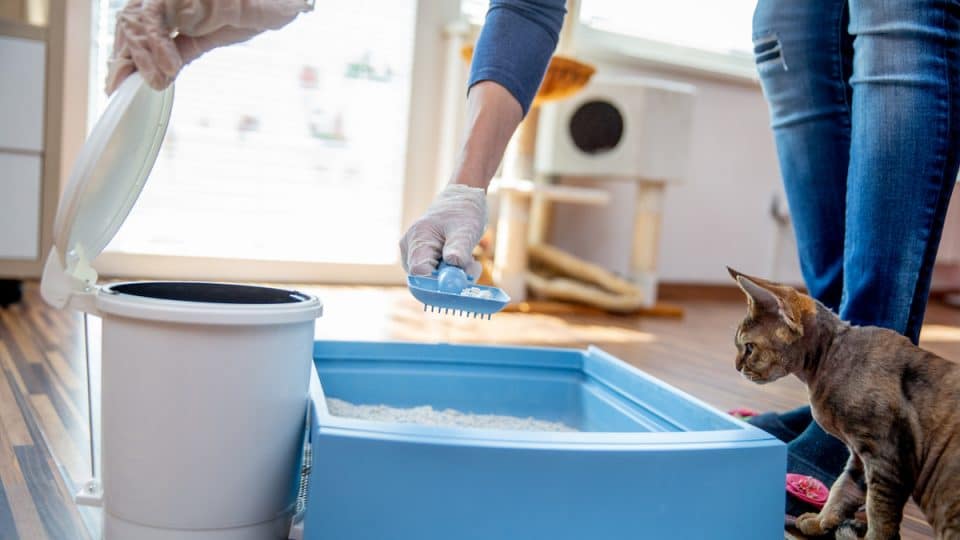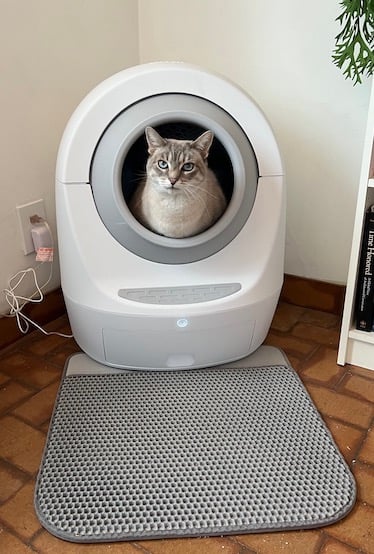There are a million things to love about cats—but keeping a litter box clean isn’t one. While this chore might not be a favourite among pet parents, it is crucial for a clean home and a happy, healthy, and hygienic cat.
For how often to change cat litter to identifying warning signs of illness, we spoke with Dr Scott M Rovner, founder and lead veterinarian at Roscoe Village Animal Hospital in Chicago, and Dr Kathleen Mottel, veterinarian at Glen Ellyn Animal Hospital, Illinois, USA.
How Often To Clean a Litter Box
Every litter box in your house needs to be scooped once per day, no matter what kind of litter you’re using. If you’re seeing issues—like pickiness or reluctance to use the litter box—Dr Rovner and Dr Mottel suggest considering scooping twice per day.
To keep bacteria from spreading, you’ll also need to fully change the litter and deep-clean the box once per month. That goes for even automatic litter boxes, which still need a monthly deep clean, even though they do the scooping for you.
So how much cleaning is that? It depends on how many cats you have. In multi-cat households, Dr Rovner and Dr Mottel emphasise the rule of thumb is one litter box per cat, plus one. That’s especially true for multi-level homes, where a secondary box on another floor (even in a single-cat household) can be ideal.
“Some felines prefer urinating in one box and defecating in another,” explains Dr Rovner. Adding an extra box will ensure that your cats have plenty of space to do their business—and that your home stays less stinky.

CasarsaGuru via iStock
How To Effectively Scoop a Litter Box
Scooping each litter box in your home once or twice a day is the best way to reduce odour and keep your cat’s private area free of bacteria.
‘Scooping litter’ means removing any solid matter (ie clumps of urine and faecal matter) from the box and disposing of waste in a plastic trash bag or a litter disposal system.
Once you’ve scooped the waste, stir the leftover litter to help distribute fresh particles and make the litter last longer.
You’ll also want to sweep or vacuum your cat’s litter mat to keep the area around the litter box tidy and prevent the spread of bacteria.
When not to scoop litter
It’s recommended that women who are pregnant or people who are severely immunocompromised avoid scooping or deep-cleaning the litter box as much as possible. This is due to the risk of toxoplasmosis, an infection picked up from contact with cat faeces.
Self-cleaning litter boxes are a great way to minimise scooping manually, but humans will still be responsible for disposing of waste. And, of course, once you’ve successfully scooped and tidied, ensure you wash your hands!
Deep Cleaning Your Cat’s Box
A monthly deep clean of your cat’s litter box is essential to keeping your home clean and your cat healthy. “Empty all of the litter in the box every 21 to 30 days,” advises Dr Rovner. “In addition, the box can be cleaned with mild soap, rinsed well, and then refilled with clean litter.”
When washing out the litter box tray, opt for a pet-friendly, unscented soap. Strongly scented soap can deter your cat from using their freshly cleaned box, and certain cleaning products can also include hazardous chemicals. Soak the tray for 30 minutes, scrub it clean, and then rinse and dry—good as new!
To deal with stuck-on clumps of cat urine, use the tried-and-trested litter box cleaning hack of baking soda and vinegar. Simply sprinkle baking soda in the rinsed tray and let vinegar soak for about 15 to 20 minutes. Rinse this solution thoroughly before adding a clean batch of litter.
Once cleaned, add about three inches of litter to the box, and your feline will be good to go.
Pro tip: if you’re worried that your cat will need the box before you’ve finished, utilise a temporary solution such as a travel litter box.

Mila Naumova via iStock
Cat-safe litter box cleaners
To avoid an unwanted trip to the vet, you’ll want to keep hazardous chemicals at bay when disinfecting your cat’s litter box and litter-related items.
Cleaners to use:
- mild, unscented soap for a deep clean
- baking soda and vinegar for stuck-on litter
- pet-safe enzymatic cleaning products for quickly freshening litter box sand and pebbles
Cleaners to avoid:
- bleach
- ammonia-based cleaners
- rubbing alcohol
- products with phenols and phthalates
- formaldehyde
- chlorine
How To Dispose of Cat Litter
Once you’ve cleaned your cat’s box, it’s time to dispose of the waste. If the litter box isn’t near a rubbish bin, consider keeping a litter disposal system close by for daily scooping. Traditional litter, including products made with clay, should be placed in a bag and thrown out with your regular household trash.
Tossing out waste seems simple, but there are a couple of important dos and don’ts when it comes to managing a litter box:
- Don’t flush litter waste down the toilet. While certain types of litter are flushable, disposing of the wrong type of litter down the drain can cause serious clogs and plumbing problems!
- Do tie up your garbage bag to reduce smell and bacteria when disposing of litter in your home.
- Don’t dump litter waste outside.
- Do vacuum/sweep and disinfect the area surrounding the litter box after cleaning. This ensures stray litter pebbles or clumps are tidied up.
Monitoring Your Cat’s Health
According to Dr Rovner and Dr Mottel, staying vigilant about new litter box-related behaviours can help identify warning signs of illness.
“Cat owners should be attentive to their feline companion’s litter box to detect excessive urine clumps, which may signify heightened urination,” says Dr Rovner. “This could signal the presence of several underlying conditions, including chronic renal disease, diabetes mellitus, and various other ailments.”
On the flip side, too little urine could indicate urinary tract issues such as feline idiopathic cystitis, urinary tract infections, or the formation of mucus plugs and crystals. Plus, if your cat suddenly starts doing the post-litter box zoomies and hasn’t made a habit of this before, this could signal that something is awry.
“If there are any changes in the frequency of urination, new habits of urinating/defecating outside the box, or if your cat takes a long time to do their business, it’s worth a visit to the vet,” says Dr Mottel.
Litter Box FAQs
What are the best places to put a litter box?
Just like humans, cats need a little privacy too! If possible, place your cat’s litter box away from high-traffic areas in the home, ideally in a well-ventilated area. You might consider putting your cat’s box in a quiet, tucked-away place like the laundry room or bathroom if space allows.
Avoid placing a litter box in the kitchen where food is prepared, in a noisy area, or next to another litter box. (The good news is there are plenty of aesthetically pleasing litter box options these days, which means your kitty’s toilet doesn’t need to be an eye sore!)
Do I need to deep-clean if I use a litter box liner?
While litter liners can help keep your cat’s box clean, they aren’t essential. Some cats can scratch through the liner while burying their business. If you choose to use a liner, you’ll still want to efficiently clean the litter tray to reduce the spread of bacteria at least once per month.
How do I clean the litter box if my cat has worms?
If your cat has worms, you’re due for a deep clean! To stop the spread, dispose of all litter in the tray and soak the box with boiling water before cleaning it with pet-friendly soap or baking soda and vinegar. Consider wearing gloves and thoroughly wash your hands after everything is clean.
How can I manage my cat’s litter box while away from home?
Cats are fairly self-sufficient and can be left alone for up to 24 hours. If you’re going to be away from home for more than a day, a trusted pet sitter can help keep your feline companion happy and healthy—and keep that litter scooped! Even if you have a self-cleaning litter box in your household, consider a sitter to give your kitty company.




